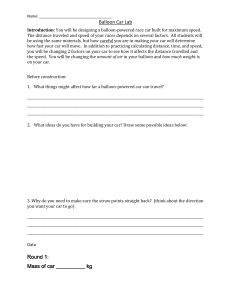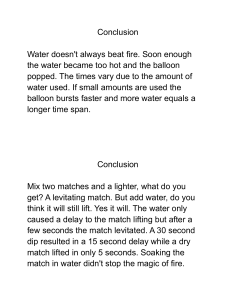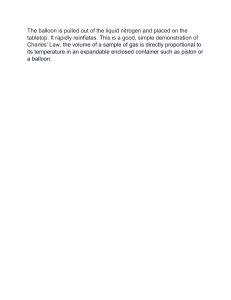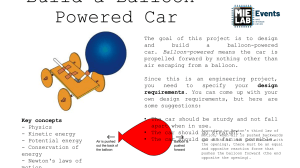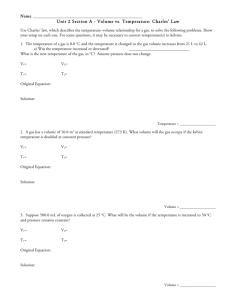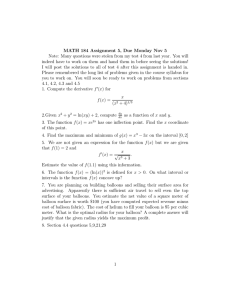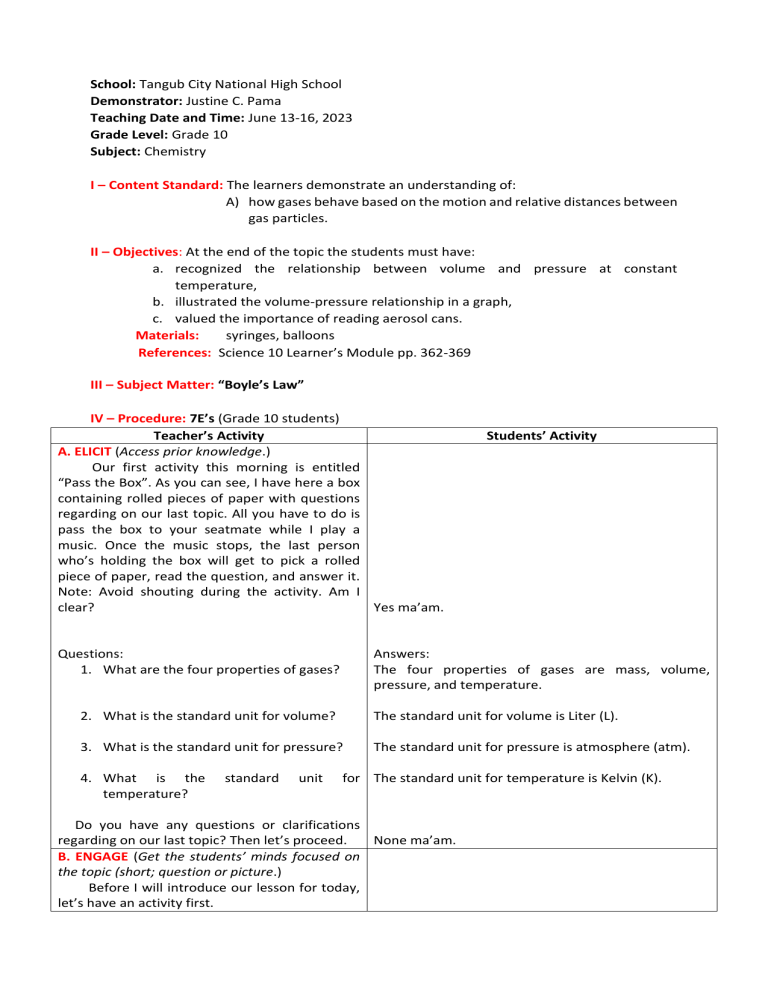
School: Tangub City National High School Demonstrator: Justine C. Pama Teaching Date and Time: June 13-16, 2023 Grade Level: Grade 10 Subject: Chemistry I – Content Standard: The learners demonstrate an understanding of: A) how gases behave based on the motion and relative distances between gas particles. II – Objectives: At the end of the topic the students must have: a. recognized the relationship between volume and pressure at constant temperature, b. illustrated the volume-pressure relationship in a graph, c. valued the importance of reading aerosol cans. Materials: syringes, balloons References: Science 10 Learner’s Module pp. 362-369 III – Subject Matter: “Boyle’s Law” IV – Procedure: 7E’s (Grade 10 students) Teacher’s Activity A. ELICIT (Access prior knowledge.) Our first activity this morning is entitled “Pass the Box”. As you can see, I have here a box containing rolled pieces of paper with questions regarding on our last topic. All you have to do is pass the box to your seatmate while I play a music. Once the music stops, the last person who’s holding the box will get to pick a rolled piece of paper, read the question, and answer it. Note: Avoid shouting during the activity. Am I clear? Yes ma’am. Questions: 1. What are the four properties of gases? Students’ Activity Answers: The four properties of gases are mass, volume, pressure, and temperature. 2. What is the standard unit for volume? The standard unit for volume is Liter (L). 3. What is the standard unit for pressure? The standard unit for pressure is atmosphere (atm). 4. What is the temperature? standard unit for The standard unit for temperature is Kelvin (K). Do you have any questions or clarifications regarding on our last topic? Then let’s proceed. None ma’am. B. ENGAGE (Get the students’ minds focused on the topic (short; question or picture.) Before I will introduce our lesson for today, let’s have an activity first. Presentation: Now class, do you know that there is a certain law which states that there is a relationship between volume and temperature? If that’s the case, sit properly, and widen your mind as we are going to discover the volumetemperature relationship. Everybody read. Yes ma’am. The balloon is being inflated with helium gas and lighted with a match which grew bigger in its size until it exploded. Yes ma’am. The volume of the balloon increases because volume is the size or the amount of space a certain substance occupies. And the size of the balloon from the first scenario showed that it expands. The lighted match causes the balloon to increase in volume because it produces heat. Temperature ma’am. The volume of the balloon grows smaller or decreases. No ma’am. “Charles’s Law” C. EXPLORE (Provide students with a common experience.) Before we will start our discussion, let us first have another activity. But before we will start our activity, let me show you first the objectives for today’s lesson. Everybody read. At the end of the topic the students must have: A) recognized the relationship between volume and temperature at constant pressure, B) illustrated the volume-temperature relationship in a graph, C) applied the Charles’s Law in solving problems. Activity 1: I will group you into 4 groups. As you can see, I have here with me some materials that will be used in this activity. Materials: (4) 700 mL beaker (4) balloon (4) container Ice Heater (4) Thermometer Procedures: (For hot water) 1. Inflate the balloon in a small size enough to be put inside the beaker. (There should be enough space for the balloon to bulge/expand.) 2. Measure the circumference of the balloon using a tape measure and record it. 3. Pour 300 mL of hot water in the beaker. 4. Get the temperature reading of the hot water. 5. Put the balloon inside the beaker together with the hot water and observe. 6. After observing what happened, measure again the circumference of the balloon. (Do these procedures for the cold water.) While doing this activity, you are going to fill up the table that will be given to you and answer the following questions: 1. What happens to the size of the balloon as the temperature increases? 2. What happens to the size of the balloon as temperature decreases? 3. How does the change in the temperature relate to the volume of gas in the balloon? Note: Handle the laboratory apparatuses properly. I will give you 5 minutes to do this activity. Yes ma’am. Each group must select one representative who None ma’am. will discuss or explain what happened to their activity and what are the results. Am I clear? Students’ Table: Do you have any questions or clarifications? Set-up Average Average Circumference of Then your time will start now! Temperature the Balloon (After 5 minutes) (℃) Before After Difference Time is up! Let’s start with group 1. Warm water Cold water Students’ possible answer to the question: A1: The size of the balloon becomes bigger. A2: The size of the balloon becomes smaller. A3: Directly proportional. (The rest of the group presents their work.) D. EXPLAIN (Teach the concept. Should include interaction between teacher and students.) To know more about the concept of the activity that you did a while ago, let’s discuss the relationship between the volume and temperature at constant pressure in Charles’s Law. But before that, let me introduce to you the man who discovered this law. Jacques-Alexandre-César Charles (1746-1823) – was born in France. A French mathematician, physicist, and inventor who was the first to ascend in a hydrogen balloon. He developed the Charles’s law concerning the thermal expansion of gases. Charles’s Law: “At constant pressure, the volume of a fixed amount of gas is directly proportional to temperature.” In his experiment, Jacques Charles trapped a sample of gas in a cylinder with a movable piston in water bath at different temperatures. He found out that different gases decreased their volume by factors 1/273 per ℃ of cooling. With this rate of reduction, if gas will be cooled up to -273 ℃, it will have a zero volume. Just like the activity that you did a while ago. You measure the circumference of the balloon before soaking it in a hot water. While soaking it in a hot water, the balloon starts to grow bigger than its original size. While soaking it in the cold water, the balloon starts to grow smaller than its original size. Therefore, this law simply means that as the temperature increases, the volume also increases. And as the temperature decreases, the volume also decreases at constant pressure. Charles’s Law can be mathematically as: 𝑽 ∝ 𝑻 𝒂𝒕 𝒄𝒐𝒏𝒔𝒕𝒂𝒏𝒕 𝑷 expressed Where: V = Volume and T = Temperature expressed in Kelvin Why is there a need to convert ℃ 𝑡𝑜 𝐾? Kelvin is the basic unit for measuring temperature in the International System (SI). “It denotes the absolute temperature scale whereby 0K or absolute zero is defined as the temperature when molecules will have the lowest energy.” Removing the proportionality symbol (∝) and using the equality sign (=) the equation will be as follows: 𝑽 𝑽 = 𝒌𝑻 𝑜𝑟 𝒌 = 𝑻 Thus, in a direct proportion, the quotient of the variable is constant. If you are going to consider the initial and final conditions, you will arrive at the following equations: 𝑉1 𝑉2 = 𝑘 𝑎𝑛𝑑 =𝑘 𝑇1 𝑇2 Whereas, 𝑽1 is the initial volume and 𝑽𝟐 is the final volume 𝑻𝟏 is the initial temperature and 𝑻𝟐 is the final temperature If the volume-temperature ratios are the same in the initial and final conditions, then we will arrive at this equation: 𝑽𝟏 𝑽𝟐 = 𝑻𝟏 𝑻𝟐 To illustrate the mathematical equations, let’s apply Charles’s Law in solving problems related to volume-temperature relationship in gases. Sample Problem: An inflated balloon with a volume of 0.75 L at 30 ℃ was placed inside the freezer where the temperature is – 10℃. Find out what will happen to the volume of the balloon if the pressure remains constant. Just like we did before, let’s start with the given variables: Initial Conditions Final Conditions 𝑽𝟏 = 𝟎. 𝟕𝟓 𝑳 𝑽𝟐 = ? 𝑻𝟏 = 𝟑𝟎℃ = 𝟑𝟎𝟑𝑲 𝑻𝟐 = −𝟏𝟎℃ = 𝟐𝟔𝟑𝑲 Convert the temperature to Kelvin. Initial Temperature: 𝐾 = ℃ + 273.15 = 30 + 273.15 𝑲 = 𝟑𝟎𝟑 Final Temperature: 𝐾 = ℃ + 273.15 = −10 + 273.15 𝑲 = 𝟐𝟔𝟑. 𝟏𝟓 Solve for the final volume. (0.75𝐿)(263.15𝐾) 𝑉1 𝑇2 197.36𝐿 𝑉2 = = = 𝑇1 303𝐾 303 = 𝟎. 𝟔𝟓𝑳 You can see from the solution that the volume decreases because the temperature decreases too. In this case, the volume between the gas molecules decreases because the kinetic energy is also affected by the temperature. Gas molecules move slowly at low temperature, thus there is less collision and so it will occupy smaller space. Let’s have another example: 3.1 𝑐𝑚3 of a gas have a temperature of 15℃. What temperature is required to increase the volume to 3.5 𝑐𝑚3 with pressure remaining constant? Who wants to solve example #2? Yes student 1? Initial Conditions Final Conditions 𝟑 𝑽𝟐 = 3.5 𝑐𝑚3 𝑽𝟏 = 𝟑. 𝟏 𝒄𝒎 𝑻𝟏 = 𝟏𝟓℃ = 𝟐𝟖𝟖. 𝟏𝟓𝑲 𝑻𝟐 = ? Convert the temperature to Kelvin. Initial Temperature: 𝐾 = ℃ + 273.15 = 15 + 273.15 𝑲 = 𝟐𝟖𝟖. 𝟏𝟓 Solve for the final temperature. (3.1 𝑐𝑚3 )(288.15𝐾) 𝑉2 𝑇1 893.27 𝑇2 = = = 3 𝑉1 3.5 𝑐𝑚 3.5 = 𝟐𝟓𝟓. 𝟐𝟐𝑲 Yes ma’am. Is his/her answer correct class? Okay very good! Clap your hands for student None ma’am. 1. Do you have any questions or clarifications? Then I will be the one who’s going to ask you some questions. Values Integration Why do you think it is important for us to know the relationship between volume and It is important for us to know the relationship between temperature at constant pressure especially volume and temperature to understand how hot air when we are going to ride a hot air balloon? balloons float. Without knowing how this relationship works, we wouldn’t be able to discover hot air balloons. Okay very good! It is important for us to know the relationship between volume and temperature at constant pressure to understand how hot air balloons float. Without further knowledge with this kind of law, Jacques Charles wouldn’t be able to discover hot air balloons. And people wouldn’t get to experience riding it. Understanding Charles’s law will give us knowledge on how things with gases expand or inflate such as balloons, balls, and the new discovered sky lanterns people use to celebrate special occasions such as Christmas or New Year. It also gives us tips on how to restore a dented/skewed Ping-Pong balls by doing the Yes ma’am. same activity that you did to the balloon a while ago. Am I understood? Then let’s proceed to our last activity. E. ELABORATE (Students apply the information learned from the Explain.) Activity 2: Illustrating Charles’s Law in a Graph Directions: Group the students into 4. Let them get a book and refer to page 373. They will be given a graphic organizer and a graph for their answers. Write their solutions in converting ℃ to Kelvin in a one whole sheet of paper. (5 minutes only) Problem: A gas cylinder was measured to have different volumes at different temperature as shown in Table 8. Complete the table with the necessary information. Plot the data from Table 8 in a graph by placing the volume in the y axis and temperature at Kelvin scale in the x axis. Trial Volume Temperature Temperature Reading (℃) (K) (mL) 1 25 2 2 30 57 3 35 102 4 40 152 V. – EVALUATE (How will you know the students have learned the concept?) (Problem Solving) Directions: Solve the following problems and show your solution. Convert the final volume to liters (L). Write your answer in a one whole sheet of paper. 1. A cylinder with a movable piston contains 250 𝑐𝑚3 air at 10℃. If the pressure is kept constant, at what temperature would you expect the volume to be 150𝑐𝑚3 ? 2. A tank (not rigid) contains 2.3 L of helium gas at 25℃. What will be the volume of the tank after heating it and its content to 40℃ temperature at constant pressure? 3. At 20℃, the volume of chlorine gas is 15𝑑𝑚3 . Compute for the resulting volume if the temperature is adjusted to 318K provided that the pressure remains the same. VI. – EXTEND (Deepen conceptual understanding through use in new context.) Directions: Answer the question given in a ½ crosswise sheet of paper. 1. Who introduced the Gay-Lussac’s Law? (Give a little background) 2. State the Gay-Lussac’s Law and explain. 3. What is the mathematical expression of the law?
